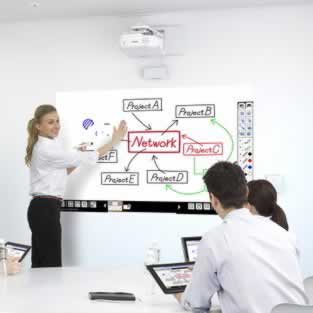At InfoComm 2014, collaboration was a key theme among conference exhibitors

Enhancing collaboration was a key theme at InfoComm 2014 in Las Vegas last week, as conference exhibitors demonstrated several audio-visual products designed to help students, educators, and other professionals work together on projects and easily share information.
These new AV tools included interactive displays with a growing number of “touch points,” as well as products designed to create ever-larger workspaces—and systems that allow for two-way collaboration between teachers and students using any device.
For instance, Sharp demonstrated the next generation of its Aquos Board interactive displays, which include apps for collaborating on a lesson through smart phones or tablets.
Available in 60-inch and 70-inch models, the Aquos Board 2 touch-screen displays recognize up to ten points of contact from as many as four simultaneous users using either a finger or an interactive pen, and the accompanying apps—available for iOS, Android, and Windows 8 devices—support “one to many” and “many to one” approaches to instruction, Sharp says.
With the free Touch Display Link app, students can receive content from the Aquos Board directly on their mobile devices. They can add their own notes to their presentation and save these notes without affecting the original content.
And with Sharp’s wePresent app, students can wirelessly display their own documents, presentations, photos, and other content on the Aquos Board from any PC, Mac, smart phone, or tablet. Up to four screens can be shown simultaneously.
(Next page: New AV products from Epson, Barco, AMX, FSR, Panasonic, BenQ, and NEC, designed with collaboration in mind)
Epson offers even more opportunities for collaboration with its new BrightLink Pro projectors. These second-generation interactive projectors transform any flat surface into a digital whiteboard, using built-in tools that don’t require a computer or software to operate. The new BrightLink Pro series also features a Whiteboard Sharing Tool that allows up to 16 participants to collaborate within the whiteboard environment from any mobile device with a web browser.
The Whiteboard Sharing Tool offers three levels of collaboration to manage simultaneous users, Epson says: Teachers can let their students view presentations only, edit or annotate presentations without adding pages, or have full editing privileges. And with Epson’s free iProjection app, students can display their own presentations, documents, or photos from any iOS or Android device.
The new BrightLink Pro series includes two projector models. The 1430Wi (list price $2,999) supports gestures, up to six points of contact with a finger, and two points of contact with an interactive pen. The 1420Wi (list price $2,799) uses interactive pens only. Both models feature WXGA resolution and 3,300 lumens of color and white light brightness.
During InfoComm 2014, Barco discussed how the Charter School of San Diego is using its ClickShare product to boost collaboration in the classroom.
“ClickShare came to our attention when we were exploring options for screen-sharing solutions to create a more inclusive educational experience,” said Tiffany Yandell, operations coordinator for the school, in a case study. “ClickShare has brought a new dimension to our workshops, encouraging teachers and students to engage in a lively dialog to enrich the lessons.”
ClickShare consists of a wireless base station that controls the collaboration system, as well as “buttons” that plug into students’ computers or mobile devices through a USB port—and sharing content with the group is as easy as clicking this button, Barco says. (Apps for iOS and Android devices are available as well, so students can share content from an iPad or other device without a USB port.)
The Classic version of the product allows for 64 simultaneous users, with up to four users’ screens displaying at once, and it sells for $3,995 (with four buttons included). The Mini version allows for eight simultaneous users, though only one person’s screen displays at a time, and it sells for $1,750 (with two buttons included). Additional buttons are sold separately.
AMX, which announced that it had been acquired by HARMAN during InfoComm, showed enhancements to its Enzo content sharing and conferencing platform. Besides retrieving content from cloud-based storage, the web, or a local USB drive for presentations, participants in meetings and classes can instantly “screen mirror” content from their laptop, smart phone, or tablet with Enzo, using MirrorOp wireless mobile content sharing technology. That means students or others can quickly and easily share their screens with just a click, AMX said.
FSR introduced a line of multi-user collaboration stations at InfoComm. Available in various models, the HuddleVU collaboration system allows for multiple users to share and view their laptops, tablets, and smart phone screens on a main display.
Anyone participating can be a presenter or a learner at any given time at the push of a button, and LED lights indicate which user is currently live and when the system is busy. The models allow for anywhere from four to 12 simultaneous users.
Panasonic debuted a new line of interactive LCD displays that support up to six touch points with a finger, ranging in size from 50 inches to 80 inches diagonally. As with the company’s latest projectors, these displays have a technology called Miracast built in, Panasonic said—which facilitates collaboration by allowing users to show content from their own device wirelessly using any device that supports the Miracast screencasting standard, such as a laptop or tablet running Windows 8.1 or Android 4.2 or later.
A few companies showed products that combine multiple interactive projectors and edge-blending software to create a giant collaborative workspace.
For instance, BenQ offers what it calls a “digital chalkboard” system that creates an interactive writing surface that’s about 12 feet long. The $2,000 system consists of two 3,200-lumen, WXGA-resolution, 3D-ready projectors that are mounted from the ceiling a few feet apart from each other, along with a writing surface, four interactive pens, and software that ties the two projectors together to create a single, interactive workspace.
NEC demonstrated a similar two-projector system, and the company said it’s able to blend up to four projectors altogether—creating a giant interactive surface with up to 255 unique touch points.
Follow Editorial Director Dennis Pierce on Twitter: @eSN_Dennis.
- Can technology help schools prevent AI-based cheating? - April 14, 2023
- How to ensure digital equity in online testing - July 6, 2022
- ‘Digital skills gap’ threatens innovation - May 30, 2022

